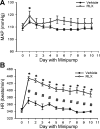Relaxin-mediated renal vasodilation in the rat is associated with falls in glomerular blood pressure
- PMID: 29046312
- PMCID: PMC5867670
- DOI: 10.1152/ajpregu.00148.2017
Relaxin-mediated renal vasodilation in the rat is associated with falls in glomerular blood pressure
Abstract
Relaxin (RLX) is a pleiotropic peptide hormone with marked renal vasodilatory actions that are physiologically important during pregnancy. RLX also has potent antifibrotic actions and is being tested therapeutically in various fibrotic diseases, including chronic kidney disease (CKD). Since renal vasodilation may expose the glomerulus to increased blood pressure [glomerular capillary pressure (PGC)], which exacerbates progression of CKD, we assessed the glomerular hemodynamic actions of acute (0.89 µg·100 g body wt-1·h-1 iv over 75 min) and chronic (1.5 µg·100 g body wt-1·h-1 sc) administration of RLX. Both acute and chronic RLX produced marked renal vasodilation and increased renal plasma flow (RPF) in euvolemic, anesthetized male rats. Glomerular filtration rate also increased with RLX, but the magnitude of the rise was much less than the increase in RPF due to concomitant decreases in filtration fraction. The fall in filtration fraction was the result of significant decreases in PGC, despite a slight increase in mean arterial blood pressure (MAP) with acute RLX and no net change in MAP with chronic RLX. This fall in PGC occurred because of the "in-series" arrangement of the afferent and efferent arteriolar resistance vessels, which can regulate PGC independently of MAP. With both acute and chronic RLX, efferent arteriolar resistance vessels relaxed to a greater extent than afferent arteriolar resistance vessels, thus producing falls in PGC. Based on this finding, RLX has a beneficial hemodynamic impact on the kidney, which, together with the antifibrotic actions of RLX, suggests a strong therapeutic potential for use in CKD.
Keywords: GFR; afferent and efferent arterioles; renal plasma flow.
Figures

Similar articles
-
Relaxin is a potent renal vasodilator in conscious rats.J Clin Invest. 1999 Feb;103(4):525-33. doi: 10.1172/JCI5630. J Clin Invest. 1999. PMID: 10021461 Free PMC article.
-
Benidipine dilates both pre- and post-glomerular arteriole in the canine kidney.Hypertens Res. 2001 Jul;24(4):429-36. doi: 10.1291/hypres.24.429. Hypertens Res. 2001. PMID: 11510756
-
Differential effect of T-type voltage-gated Ca2+ channel disruption on renal plasma flow and glomerular filtration rate in vivo.Am J Physiol Renal Physiol. 2014 Aug 15;307(4):F445-52. doi: 10.1152/ajprenal.00016.2014. Epub 2014 Jun 25. Am J Physiol Renal Physiol. 2014. PMID: 24966091
-
Renal function during normal pregnancy and preeclampsia.Front Biosci. 2007 Jan 1;12:2425-37. doi: 10.2741/2244. Front Biosci. 2007. PMID: 17127252 Review.
-
Role of actions of calcium antagonists on efferent arterioles--with special references to glomerular hypertension.Am J Nephrol. 2003 Jul-Aug;23(4):229-44. doi: 10.1159/000072054. Epub 2003 Jul 1. Am J Nephrol. 2003. PMID: 12840599 Review.
Cited by
-
Relaxin mimetic in pulmonary hypertension associated with left heart disease: Design and rationale of Re-PHIRE.ESC Heart Fail. 2025 Jun;12(3):1956-1964. doi: 10.1002/ehf2.15203. Epub 2025 Jan 20. ESC Heart Fail. 2025. PMID: 39829393 Free PMC article.
-
Novel Relaxin Receptor RXFP1 Agonist AZD3427 in the Treatment of Heart Failure: A Phase 1a/b, First-in-Human, Randomized, Single-Blind, Placebo-Controlled Study.J Am Heart Assoc. 2024 Aug 6;13(15):e034067. doi: 10.1161/JAHA.123.034067. Epub 2024 Jul 26. J Am Heart Assoc. 2024. PMID: 39056338 Free PMC article. Clinical Trial.
-
Relationship between Falls and the Use of Medications and Diseases in an Otago Exercise Programme in Old People Living in the Community in Spain.Healthcare (Basel). 2023 Mar 31;11(7):998. doi: 10.3390/healthcare11070998. Healthcare (Basel). 2023. PMID: 37046925 Free PMC article.
-
The Endothelin System: A Critical Player in the Pathophysiology of Preeclampsia.Curr Hypertens Rep. 2018 Apr 10;20(4):32. doi: 10.1007/s11906-018-0828-4. Curr Hypertens Rep. 2018. PMID: 29637419 Free PMC article. Review.
-
Pregnancy after Kidney Transplantation-Impact of Functional Renal Reserve, Slope of eGFR before Pregnancy, and Intensity of Immunosuppression on Kidney Function and Maternal Health.J Clin Med. 2023 Feb 15;12(4):1545. doi: 10.3390/jcm12041545. J Clin Med. 2023. PMID: 36836080 Free PMC article.
References
-
- Baylis C, Brenner BM. The physiological determinants of glomerular ultrafiltration. In: Reviews of Physiology, Biochemistry and Experimental Pharmacology, edited by Ulrich K. Berlin Heidelberg: Springer-Verlag, 1978, vol. 80, p. 1–46. - PubMed
-
- Brenner BM. Nephron adaptation to renal injury or ablation. Am J Physiol Renal Fluid Electrolyte Physiol 249: F324–F337, 1985. - PubMed
Publication types
MeSH terms
Substances
Grants and funding
LinkOut - more resources
Full Text Sources
Other Literature Sources
Medical
Miscellaneous

